Funny Cop Arrest Gjy Screams Bevause of Tasrer
T he sentencing hearing began with a surprise. Timothy Runnels, a 32-year-old former Independence, Missouri, police officer, sat at a large, rectangular defense table inside Courtroom 8B at the Charles Evans Whittaker Federal Courthouse in downtown Kansas City, Missouri, late last month. He was waiting to learn his fate after pleading guilty to a federal crime he committed almost two years ago, on September 14, 2014. Judge Dean Whipple had not yet watched the government's key piece of evidence — a dashboard video — because he wanted to do so with attorneys present to make arguments. Today the video, which had never been played in any public setting, would be played in open court. Even the victim, 18-year-old Bryce Masters, had seen it only once.
As the video opens we see a gray Pontiac enter the frame, and Bryce's dad, Matt, put his hand on his son's knee. His mom, Stacy, folded her arms, clutching a tissue. Tears began to form in both his parents' eyes, anticipating what everyone else in the room was about to see. Unfazed, Bryce leaned his 6-foot-1-inch frame forward, his eyes focused on the makeshift projector. He knew this piece of evidence absolved him of any wrongdoing.
In the video, Runnels pulls Bryce over and approaches the car. He tells Bryce to get out but doesn't give a reason. Bryce repeatedly asks if he is under arrest. Runnels says, "You're under arrest. Get your ass out of the car," and attempts to pull him out by force. He then tases Bryce for 23 seconds, handcuffs him, drags the boy's body behind the car, and deliberately drops him face first onto the asphalt road. Runnels may not have known it at the time, but Bryce was going into cardiac arrest. When the loud thud of the drop boomed throughout the courtroom, gasps echoed out. One woman looked down and covered her eyes with her hand. A man said, "Oh, my god." A police officer with the Kansas City Police Department quickly brought his fist to his mouth, turned to the man next to him, and whispered, "Jesus." Even those sitting behind the defendant — a few friends, his wife, his family — gasped, as if the recording revealed a truth about Runnels they had never considered.
Runnels faced a dire sentence that day — up to 10 years in federal prison. The catalyst for the crime was the 23-second Taser deployment straight into Bryce's chest. That's what caused him to go into cardiac arrest. Assistant U.S. Attorney David M. Ketchmark argued that the length of time that Runnels held down the Taser's trigger was an aggravating factor. One pull on the trigger sent electricity shooting out for five seconds; Runnels had held it down the equivalent of four pulls. Even so, the prosecution agreed that the initial Taser use was reasonable and within common police practice. Runnels's crime, depriving a minor of his civil rights, occurred when he dropped the dying 17-year-old boy on his face.
Matt Masters does not agree that the Taser use was reasonable, but he agrees it was common police practice. Matt is a 19-year veteran of the Kansas City Police Department with a slew of warrior-cop credentials. He has worked on SWAT teams and has been part of Kansas City's police narcotics unit, taking point on an estimated 1,000 search warrants during one three-year span. After Bryce was tased, Matt discovered something he'd never heard in any Taser training he'd gone through, something he resisted believing, because it violated an article of faith among police officers: Tasers can kill.
More specifically, Matt learned that on October 12, 2009, Taser International, the Scottsdale, Arizona-based maker of conducted electrical weapons, released a training bulletin suggesting that officers should avoid shooting suspects in the chest whenever possible. Five years later — on September 14, 2014 — it would be difficult to argue that Runnels was unable to avoid shooting Bryce in the chest. Yet the defense's argument for leniency was based on the claim that Runnels had acted reasonably as an officer right up until the moment he dropped Bryce on his face.
But the wounds Bryce suffered from that part of the assault have largely healed. The permanent injury he struggles with every day came as a result of the Taser. Bryce's brain was deprived of oxygen for six to eight minutes while he was in cardiac arrest. It was the Taser that almost killed Bryce.
I ndependence, Missouri, is an aging suburb, the kind of place wealthy residents of Kansas City used to move to. Independence is bigger than it seems — with about 117,000 residents, the fourth-largest city in the state — but still has the feel of a tight-knit, middle-class community. When Stacy and Matt Masters began having children, they moved across the border to Kansas City so Matt could keep his job as an officer with the Kansas City Police Department. Bryce and his two siblings remained in the Independence school system.
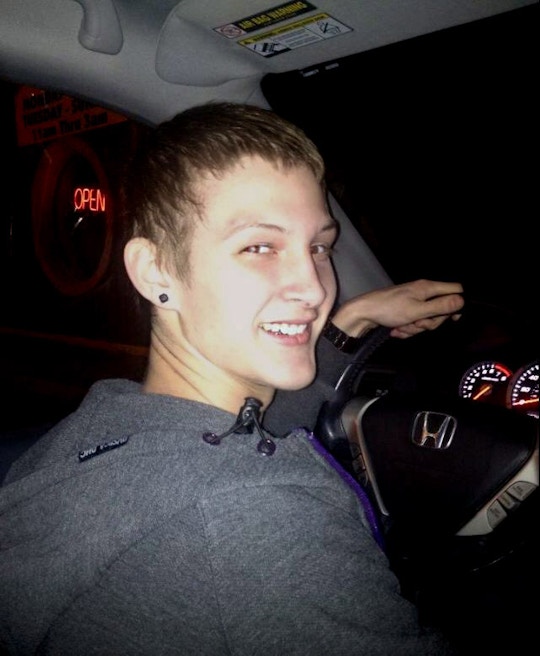
Bryce Masters, June 5, 2013.
Photo: Courtesy of the Masters family
The Masters didn't worry much about Bryce in high school. He mostly kept out of trouble and hung out with friends from school. He was athletic and made good grades. But in the summer of 2014, Bryce started having run-ins with the local police. First, according to Bryce, he and a friend named Curtis Martes were searched by two Independence officers, Travis Gillihan and Timothy Runnels. The officers found half a joint but let them go. Then one morning in August 2014, after spending the night at a friend's house in Independence, Bryce walked outside and approached his car, which was parked on the street. Officer Gillihan was involved again. Gillihan claimed he'd received a call about a suspicious car parked overnight, and he was waiting when Bryce walked outside. The officer pushed him against the car and began digging through his pockets. Bryce was carrying a small amount of marijuana in a baggie.
A friend at the Independence police station called Matt to tell him his son had just been arrested. Matt headed to jail and posted Bryce's bail. Later, when they got home and Bryce described what had happened, something about the arrest didn't seem right. Matt couldn't see any probable cause. He told Bryce that the officer shouldn't have gone into his pockets and the search was likely illegal.
Outraged, Stacy called the station and demanded to speak to the officers involved. She told the sergeant she spoke to that the family believed the officers had conducted an illegal search and that they were considering filing a complaint. The sergeant didn't respond well to the threat and told her that if she were a better mother, maybe none of this would have happened.
Matt was furious. He and Stacy sat Bryce down. They told him that they were disappointed he was smoking marijuana but that his civil rights had been violated. Matt told him that if an officer ever stopped him, he had every right to know why he was being stopped, and whether he was under arrest. The conversation was still fresh in Bryce's mind on September 14 when Officer Runnels pulled him over.
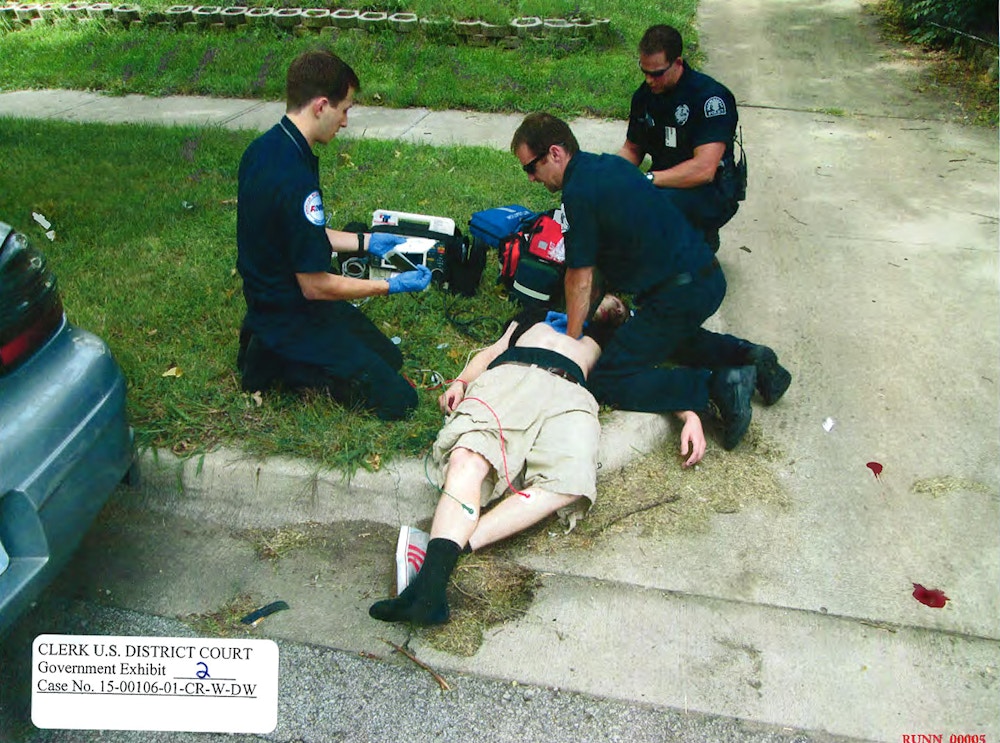
Bryce Masters received CPR after being tased by Officer Timothy Runnels (top right), Sept. 14, 2014.
Photo: Missouri U.S. District Court
B ryce's friend Curtis called Matt at about 3 p.m. that Sunday to let Matt know that Bryce had been stopped by the police outside his house, and that the officer looked like he was trying to get Bryce out of the car. Curtis thought Matt should probably come by to make sure everything was all right. As Matt and Stacy were getting ready to leave the house, Curtis called back again. "Hey Matt, get here — he just tased Bryce."
At that point, Matt and Stacy were not at all worried about Bryce's safety. They understood Tasers to be safe tools, but tools that were used on suspects who posed a threat to officers. Their immediate concern was why a police officer would use one on their son.
Minutes later, Curtis called Matt again. "He's not breathing." Matt hung up and hit the gas.
By the time the Masters arrived, paramedics were on the scene, attending to Bryce. They had him on a stretcher, ready to go to the hospital. The spot where Bryce was pulled over is suburban and residential, a paved road next to a manicured lawn with a public sidewalk running through it. But it was a crime scene at that point, with several officers there and yellow tape stretched to cordon off the section of property where the interaction had played out.
Matt was irate, screaming, "You bunch of fucking cowboys!" at the officers assembled to gather evidence. Stacy recalled pointing to one of the officers on the scene and asking Curtis, "Is that the one who did it?"
"He's got his hand up on his car, his shades on, and he's looking pleased with himself," Stacy said. Curtis told them it was one of the cops who had stopped them earlier that summer. It was Timothy Runnels.

Photo: Jason Dailey for The Intercept
M att and Stacy were upset, but they believed the worst was over. They didn't realize how long Bryce had been without oxygen. They assumed the paramedics had done CPR and that the situation was serious but under control. "We didn't think death," Matt remembered.
As the ambulance took Bryce to Centerpoint Medical Center, Matt decided to stay to make sure Independence investigators appropriately collected evidence, assuming Bryce would recover. Stacy was comfortable with Matt remaining at the scene, not realizing what she would face when she arrived at the hospital.
As Stacy walked into Centerpoint's trauma center, nurses ushered her to where Bryce was hooked up to a ventilator, still unconscious. Medical staff furiously worked around him. Nurses cut his clothes off. They put ice packs around his body to prevent his brain from swelling. They called for scans and tests. Stacy just looked on in horror.
Both blood and mucus had crusted around Bryce's nose. His face was swollen, with some dirt and asphalt mashed into his cheek. His chin was split open. His skin was pale, and his lips were light blue. It was clear he had vomited. For Stacy, though, the worst part was looking at his limbs.
Bryce was showing acute signs of decorticate posturing, a symptom of severe brain damage. His fingers and toes were curled inward, and his arms bent at near 90-degree angles toward his chest. Stacy had no idea why his body was so contorted. Finally, she asked one of the nurses. "Was he drunk, on drugs, what could do this?" "No, that's not it at all," the nurse responded. "These are classic signs of a brain injury."
Blood and mucus had crusted around Bryce's nose. His face was swollen, with some dirt and asphalt mashed into his cheek.
"What I'd seen with his posturing … made me want to look away," Stacy said. "I felt ashamed, because I didn't want to watch it. It was so unnatural." Bryce was unconscious, and no one was telling Stacy he was going to be OK. She called Matt. "It's really bad," she said. "You need to get up here."
Matt arrived at the hospital and went straight to the intensive care unit. Bryce was still getting an MRI when a neurologist working on his case pulled Matt and Stacy into a private room and explained that she had calculated Bryce's Glasgow Coma Score, a point system designed to gauge the severity of a brain injury. She told the Masters that Bryce had scored a three. The neurologist calmly explained that 15 is the best score, indicating a patient is fully aware and awake. A three is the worst possible score.
Dr. Stanley Augustin, the chief trauma surgeon, joined the conversation. He told the Masters that his staff had Bryce prepped for a procedure known as Code ICE — a "therapeutic hypothermia" that slows the blood flow of a coma patient and keeps the brain from swelling, protecting it from further damage. Bryce would spend several hours cooling down, stay cooled for a minimum of 24 hours, and then be slowly warmed back up.
It was Bryce's only option, doctors told Matt and Stacy. The odds were still against them — there was about a 50-50 chance that Bryce would emerge from the coma alive. If he did wake up, there was a good chance he would never recover beyond a vegetative state.

Bryce Masters in a coma at Centerpoint Medical Center, Independence, Missouri, Sept. 16, 2014.
Photo: Courtesy of the Masters family
M eanwhile, Independence police officials were intent on controlling the story. The first news reports about the incident included comments from a spokesperson who said Bryce was stopped for an outstanding warrant, and that he refused to follow the officer's commands. "He was just being completely uncooperative with the officer," the spokesperson told KCTV. Later, a different spokesperson would tell KCTV that "the use of the Taser was in policy." Runnels's name wasn't initially released. A tweet from the department later that night, at 7:28 p.m., read, "Carstop on Southside for warrant assoc. Driver uncooperative, struggles, taser deployed, additional struggle. AMR ordered (Taser protocol)." It was clear that officials were determined to place blame on Bryce and paint a picture of a lawful stop that escalated into a justified use of force.
The details didn't make sense to Matt and Stacy. The police kept referencing an outstanding warrant, but unless there was a ticket Matt didn't know about, Bryce's license was valid and his car had been registered to Matt and Stacy for over three years. Matt began calling all the law enforcement contacts he could, trying to figure out what might have happened.
Dozens of visitors, including many of Matt's colleagues from Kansas City, descended on the hospital to offer support. Everyone was at a loss, not just over the gravity of Bryce's medical distress, but over what had sparked the use of force to begin with. In the whirlwind of activity, Matt and Stacy realized they hadn't yet received an official medical explanation for what caused Bryce's cardiac arrest. Matt assumed it was due to positional asphyxia — a condition where breathing is inhibited because of awkward positioning or restraint.
"The Taser did this. He took a shot right to the heart, and that sent him into cardiac arrest."
Later in the evening, as things quieted down, Dr. Augustin arrived to check on Bryce. As he looked Bryce over, Matt casually floated his positional asphyxia theory. Dr. Augustin said, "That's not what happened," Matt remembered. "The Taser did this. He took a shot right to the heart, and that sent him into cardiac arrest."
The answer didn't make sense to Matt. As a police officer, his opinion about whether Tasers could kill mirrored the standard explanation he and his fellow officers had heard from the company's trainers, that Tasers causing cardiac arrest was just a tall tale concocted by attorneys and the media to disparage a useful police weapon. "Nah, that can't even happen," he remembered saying. Dr. Augustin was firm. That's what happened; there was no other plausible explanation.
Matt and Stacy didn't sleep at all that first night. They stared at Bryce as the reality that he might die washed over them. Matt asked what Stacy knew was an inevitable question, a question they needed to address. "Do you think that Bryce is going to make it?" he asked her. "I don't know," she said.
But, deep down, she understood what Bryce was up against. "In my heart of hearts, I felt like he was slipping away," she said. "And, if his future was going to be the way that they described to me if he did make it, I didn't know if I wanted him to."
B y Monday morning, September 15, Bryce's core temperature had reached 92.6 degrees — 6 degrees below normal. For the next 24 hours, he would be in limbo as his brain tried to heal itself. Stacy wanted to take responsibility for dealing with the medical staff, and the downtime gave Matt an opportunity to focus on the investigation. Matt retained his friend and former police officer Daniel Haus as the family attorney, and he called the FBI to request an investigation. The FBI told him to be patient and that an agent would contact him sometime in the next few days. About an hour later, a colleague called Matt; two FBI agents assigned to investigate police misconduct were already looking for him.
The FBI arrived within the hour. They took statements from both Stacy and Matt and started taking pictures of Bryce. They couldn't remove his breathing tube or bandages, so they focused on his chest. When they opened his hospital gown, Matt saw two bright red marks that looked like bee stings on Bryce's body. One punctured his chest, to the right of his midsection. The other punctured several inches below and slightly left of his heart.
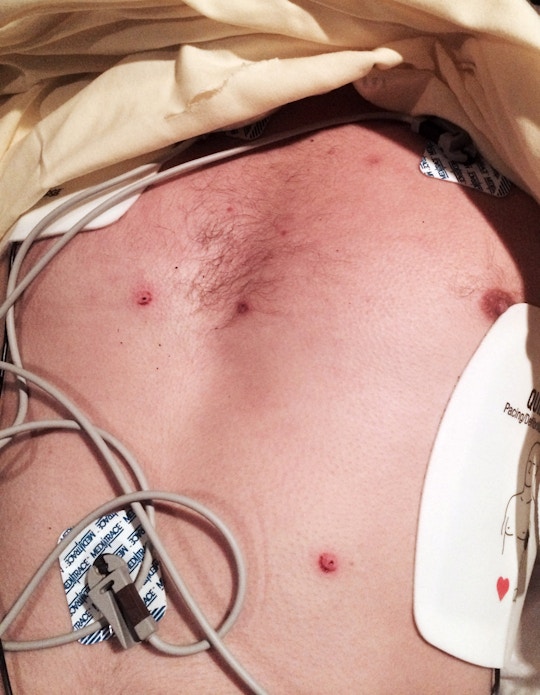
Taser puncture marks on Bryce Masters's chest and torso, Sept. 15, 2014.
Photo: Courtesy of the Masters family
Matt peppered the FBI agents with questions during that first meeting, but he didn't receive many answers. The agents would confirm only that there was a dashcam video of the incident. Both Matt and Stacy immediately wondered what it would show. More importantly, if there was no warrant associated with Bryce or his car, why was he stopped in the first place?
By Wednesday morning, Independence police released Officer Runnels' search warrant application, and the probable cause appeared to have changed. Runnels wrote that he "observed the vehicle to have darkly tinted windows," and that after Bryce partially rolled down his window, he "detected an odor of marijuana coming from inside the vehicle." Runnels maintained that there was a warrant associated with the license plate, but FBI agents told Matt that the plate number would have provided details for a woman, with a different car, from a different county.
Matt called the FBI agents he met on Monday. "You see what's happening here," Matt told them. "They're working it backwards." Matt's experience as a cop taught him that officers can sometimes write themselves out of trouble through exaggerated and self-serving reports. "Whenever you see these officers come out with a use of force, whether it be a shooting or a tasering or a whatever, there are phrases that always go in those reports, that we've been trained to put in there," Matt said. "And so many times that's just like an 'insert quote here' in your report because that's going to cover your ass."
Matt saw the phrasing and knew Runnels was looking for ways to justify both the stop and the attempted arrest. Matt suspected that once it was clear the warrant association to the car wasn't sufficient probable cause for an arrest, Runnels needed new justifications. Since smell is subjective, and difficult to prove, officers can use "marijuana odor" broadly to justify probable cause, Matt said. "Cops use that all the time."
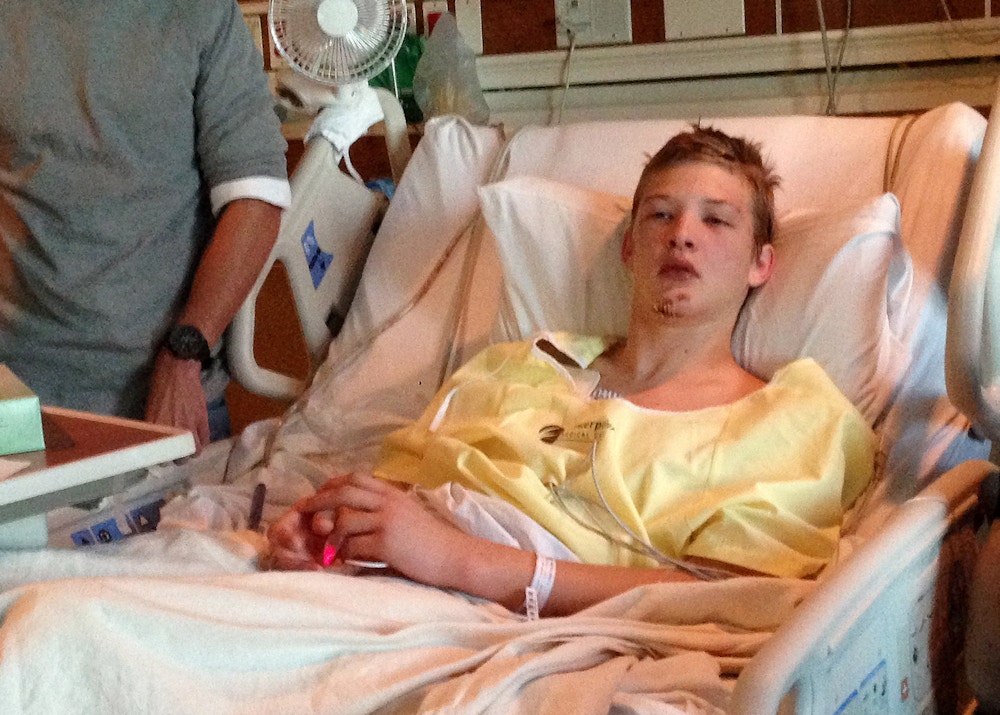
Bryce Masters awake at Centerpoint Medical Center, Independence, Missouri, Sept. 17, 2014.
Photo: Courtesy of the Masters family
W ednesday afternoon, Bryce's eyes began to scan his room inside the intensive care unit. He was completely immobilized, the ventilator still in place, but he was making eye contact with his mom and dad. Single tears began to run down his face, but his pain was a good sign. He wasn't just alive — he was demonstrating awareness.
By Wednesday evening, the medical staff was ready to give Bryce a crucial test. They turned the ventilator off, but left the breathing tube in just in case Bryce failed to breathe on his own. For 30 minutes, he had to take deep, long breaths, with his tongue depressed and a tube jammed down his throat, before the doctors felt he was out of the woods.
Stacy and Matt cried as Bryce fought. The staff had to tie his arms down as he kept reaching for his breathing tube, trying to rip it out. Finally, he was clear, and the room celebrated. His mom and dad held his hand. They still didn't know how bad the damage was, but at least Bryce recognized his parents.
Bryce has vague memories of that Wednesday night. He can recall family and friends coming in to offer their support, standing around his bed. His most vivid recollection was the intense pain coming from his mouth. He began pressing his tongue, which was raw and swollen, against his teeth. When his mom noticed, he tried to explain how strange they felt. "They're all crushed or something," he told her.
As his mom and dad moved in to take a closer look, he spat out little pieces of his teeth. At least three were sheared in half and several others badly chipped. His face was swollen, and they later found out that his jaw was likely dislocated, but popped back into place.
Matt and Stacy were livid. Matt called the FBI again. The agents arrived quickly and started taking pictures of Bryce's mouth. Matt and Stacy said the agents seemed unsurprised by the injuries. They had seen the dashboard video and had a clear picture of what happened.
"I can't tell you what is on there," Stacy remembered one agent telling them. "But it's undeniable."
It was clear that officials were determined to place blame on Bryce and paint a picture of a lawful stop that escalated into a justified use of force.
Roughly every 30 minutes that night, Bryce would forget what happened to him. He would feel his mouth and turn to his parents. "What happened to my teeth?" he asked repeatedly. Each time, Stacy and Matt tried to gently remind him that he had been injured by a police officer. He would sleep for a bit, forget again, then look in the mirror. "Who beat the shit out of me? What did I do?" It was hard to accept that a police officer, someone he was taught to trust, could injure him so grievously.
By Sunday, Bryce was ready to leave the hospital. His memory had improved a bit. Given the grim initial prognosis, the Masters felt lucky. They stopped by the intensive care unit to thank the staff. "People were just shaking their heads," Stacy said. They couldn't believe he was up walking in less than a week. "He was dead," said Matt. "It's a miracle he's alive."
Bryce tried to appreciate the moment, but he wasn't naïve. "I knew, whenever I woke up, that I didn't feel right," he said. After going for so long without oxygen, at least some brain damage was inevitable. He wondered what he could repair, and if he was ever going to be the same. As he left Centerpoint Medical Center late Sunday afternoon, he walked with a noticeable limp, dragging his right leg behind him.

Photo: Jason Dailey for The Intercept
B ryce was scheduled to start rehab the very next day. The next eight weeks were crucial to his recovery; doctors advised the Masters that Bryce would make his most significant gains in the first couple months after his injury.
Bryce was given simple tasks, "things kindergartners could do," as he put it. Drawing shapes, holding objects firmly in his hand, walking without a limp, hearing a story and trying to synopsize it back to the storyteller — things that used to be second nature were now exhausting chores. Most of the damage Bryce suffered, though, was done to his psyche. The memories he had formed over 17 years, many of the things he thought made him who he was, no longer applied. He no longer had the ability to adequately control feelings of anger, frustration, depression, and anxiety.
He found himself doing things out of character, like punching holes in the drywall at his parents' house when he became frustrated. He was mean, especially to his parents. When Stacy would try to push him in his rehab, he sometimes snapped. "Why don't you just leave me the fuck alone?"
His short-term memory loss was severe, and it exacerbated his emotional instability. Some of Bryce's memories are made and erased overnight, and sometimes more frequently. Bryce will forget that an event has occurred, and then get irritated with his parents for reminding him that it has. Then he'll get depressed at the idea that he needs to be reminded about something that just happened.
Some of Bryce's memories are made and erased overnight, and sometimes more frequently.
On April 5, for instance, Matt and Stacy wanted to surprise Bryce with tickets to a Kansas City Royals' game. The team members would receive their 2015 World Series rings that afternoon, so Matt and Stacy got Bryce up mid-morning. They wanted to spend the day down by the ballpark as a family. Bryce had other plans. "He didn't understand why we wanted to go so early, and he threw a fit," Matt said. Bryce spent the better part of 45 minutes arguing with his parents as he tried to wrap his mind around why they wanted to go to the game so early. He screamed at Stacy. It was a war of attrition. Eventually, Bryce went back to sleep.
As Matt walked around the stadium without Bryce that Sunday, he saw several Kansas City cops he knew on patrol. He hadn't seen most of them for a while, so they all made small talk. Eventually, they asked him how Bryce was doing. He politely let them know that Bryce was doing OK, leaving details unsaid.
When Matt and Stacy got home, Bryce came up to their room to talk. He felt terrible for missing the game. Matt consoled him and told him it was OK, but also said that he needed to apologize to his mom. It was unacceptable the way he'd talked to her. Bryce looked at Matt, confused. "What do you mean?" Bryce asked. He didn't remember the fight. He had assumed he couldn't wake up on time, so his parents went without him.
The totality of his injury also made him reclusive. He would get terrible headaches, he had trouble sleeping — problems that persist. But his anxiety those first few months made such issues much more debilitating. Matt and Stacy would check on him as he slept, just to make sure he was still breathing. They were overcome with the fear that his heart was still weak enough, or his brain damaged in some unexpected way, that he could die in his sleep. Worse, they were afraid his emotional vulnerability would cause him to take his own life. Bryce admits now that, given a potential lifetime of frustration, the thought crossed his mind.
When Matt went back to work, he was eager to discuss the Taser with his colleagues. Matt wondered: If Dr. Augustin was right, and the Taser caused Bryce's cardiac arrest, why hadn't he known about the risks? His initial thought was that maybe, somehow, even though he'd carried a Taser since 2004, he'd simply missed something in training. But in conversation after conversation, his fellow officers either doubted or were also surprised by Dr. Augustin's theory. Even those who had heard it was theoretically possible thought it was a fluke, like getting struck by lightning.
Matt had heard that people sometimes died after a Taser shock, but chalked it up to a syndrome called "excited delirium," which he'd learned about in his Taser training.
Matt started searching the internet for Taser deaths and cardiac arrest. First, he found a study by electrophysiologist Dr. Douglas Zipes that highlighted Taser-induced cardiac arrest cases in the field. "I read Zipes' study, and it just blew me away," Matt remembered. Dr. Zipes is one of the world's pre-eminent electrophysiologists (and often a witness against Taser International in product liability suits), so when Matt read the study he understood Dr. Augustin's certainty in Bryce's case. In the medical world, Tasers causing cardiac arrest was apparently a well-established phenomenon.
Over the next several weeks, he went down a rabbit hole of news stories about Taser-related deaths and studies examining the weapon's potential lethality. Matt had heard that people sometimes died after a Taser shock, but chalked it up to a syndrome called "excited delirium," which he'd learned about in his Taser training. "I'd never heard of excited delirium until Taser International came along."
As it happens, the concept of "excited delirium" is highly controversial. Used both as a description of a state of mind as well as a medical diagnosis, excited delirium is a phrase that medical examiners sometimes use in official reports after a person is severely injured or killed in an intense police interaction. It is not recognized by the American Medical Association or the American Psychological Association, nor is it listed in the Diagnostic and Statistical Manual of Mental Disorders. But Taser International has latched onto the diagnosis as a way to explain many deaths that occur after someone has been shocked with a Taser.
The company's use of the condition in public statements and court testimony is controversial as well. In a highly publicized Canadian inquiry into the 2007 Taser-related death of Robert Dziekanski in the Vancouver International Airport, a police psychologist accused the company of using the "mythical" disorder as a way to justify "ridiculously inappropriate" Taser use by police officers. While the number of people killed in Taser-related police interactions is in dispute — and it's unclear what role the Taser played in a number of these deaths — Amnesty International has put the figure at more than 500. Other sources, such as an informal list known as Truth Not Tasers, put the figure at nearly 1,000.

Taser International Inc. headquarters in Scottsdale, Arizona.
Photo: Patrick T. Fallon/Bloomberg/Getty Images
Taser International did not respond to multiple requests for comment.
Keeping these facts in mind, Matt thought back to his training, and Bryce's case. He started to see the holes in excited delirium as a catch-all for Taser-related deaths. "Yeah, they had a heart attack, but the Taser didn't cause it. It was because they fought, or they were stressed," he remembered hearing in his training. "Don't give me that bullshit," he now thought. "Bryce wasn't fighting anybody."
For Matt, the most damning evidence came from within Taser International itself. He read a study by Patrick J. Tchou, a cardiac electrophysiologist at the Cleveland Clinic. Tchou's study was one of the first to demonstrate that a Taser shock can potentially lead to cardiac arrest — and it was financed by Taser International and completed in 2006, eight years prior to Runnels using a Taser on Bryce.
But for another three years, Taser International training slides continued to avoid mentioning potential cardiac effects. Finally, in 2009, Taser International released the bulletin suggesting that officers should avoid shooting suspects in the chest when possible. According to the company, the preferred target area was changing for reasons that had more to do with the ineffectiveness of chest shots than any danger associated with them. Matt had never seen that bulletin. He was incredulous. "Why don't cops know all this?" Certainly some did, but for all the years Matt had carried a Taser, he didn't know. He was especially concerned about officers trained before 2009, who may have never been re-trained on updated information.
In November 2014, Bryce's case was back in the news with reports that Runnels had left the Independence police force. That same month, Matt went in for his annual in-service update — an hourlong training session in which officers go over updated information about how to legally deploy police tactics, including the use of Tasers. Matt assumed cardiac arrest would be a prominent part of the conversation.
No one said anything about avoiding the chest, and this was five years after Taser International officially changed the target area.
He was wrong. While most of the 15-minute session was spent on updated legal information, and situations in which Taser use was not advised, there was no mention of potential cardiac risks. Be careful shooting fleeing suspects. Don't use it on suspects who are just passively resisting. No one said anything about avoiding the chest, and this was five years after Taser International officially changed the target area — and with an incident involving a local officer's child providing a perfect example of what could happen.
Matt also had to endure half a dozen "funny" Taser videos between slides. His colleagues chuckled as suspects screamed and cops stood heroically at a distance, pumping them with electricity. Matt had been there before, a guy laughing in the room at the helpless contortions of Taser victims. Now, he thought about his son.
Instead of getting angry at his fellow officers, though, Matt felt sympathy for them. He realized they didn't know any better. He thought again about his own training, and how Taser International, by holding a virtual monopoly on the weapons, heavily influenced the information officers received. He had been assured by instructors, trained by Taser International, that the electric current discharged by the Taser would not cause death. (According to police spokesperson Capt. M. Tye Grant, the Kansas City Police Department updated its certification training after the bulletin was distributed in 2009 and noted the changes in a 2010 in-service update. But the information was not considered urgent enough to repeat annually.)Runnels had once been an officer in the Kansas City Police Department, though Matt didn't work in his sector.If Runnels was trained when he was hired in 2007, unless he was adequately re-certified with updated information about the risks of cardiac arrest, it was likely he and Matt had the same false understanding of the weapon they both carried.
Matt imagined the stop every day. He and Stacy had been assured by the FBI that what Runnels did crossed the line. As a cop, though, he couldn't escape the thought that Bryce had somehow provoked him. "You don't just get tased," Matt remembered thinking. "He had to have done something."
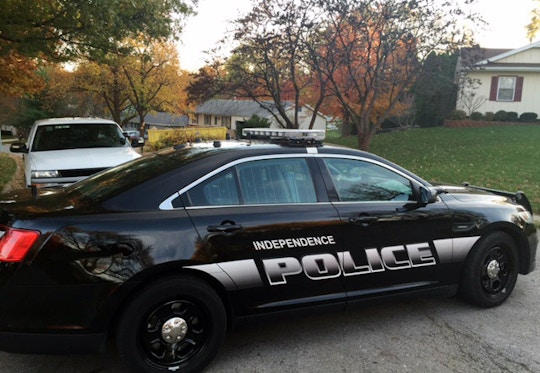
Independence Police Department squad car.
Image: KMBC
Bryce dealt with the perception that he was somehow to blame on a daily basis. Trying to go back to normal meant putting himself back in the community. The only thing the public knew was what had been reported, and what had been reported was that he resisted a lawful arrest, and his car smelled like marijuana. In every interaction, whether at school or out in public, the question of what he did, what responsibility he must have for his own injury, hung over him.
The Independence Police Department was hardest on him. Once Bryce learned to drive again, Independence squad cars followed him several times, sometimes even pulling up next to him so the officers could smirk or wave. On one occasion, he said, he was out bowling when two officers approached him and sarcastically asked how he was doing.
Matt, Stacy, and Bryce all said that the harassment has become worse. Bryce was recently ticketed for allegedly going 80 mph in a 40 mph zone by an officer who claimed he had paced the car to determine its speed instead of using a radar gun. Bryce denied he was going anywhere near that fast. Even on the night of Runnels' sentencing, Bryce said, he was followed by an Independence squad car for at least 3 miles. In another incident, a police cruiser blocked him in; a few nights later he was pulled over. The Independence Police Department did not respond to a request for comment.
Mostly Bryce struggled because he couldn't rely on his own memory of the incident. He wanted to prove himself, but he didn't know any of the details. All he had was the instinct that, as the son of a cop himself, he would have made sure to be respectful. "I knew, in my heart, that I didn't do anything wrong to him," he said.
D uring the third week of March in 2015, Assistant U.S. Attorney David M. Ketchmark informed the Masters that Runnels was going to face a grand jury. Matt was surprised. He was intimately familiar with the grand jury process and how it skewed heavily toward exonerating officers in use of force situations. Matt once received a standing ovation after a grand jury cleared him of any wrongdoing in shooting a 16-year-old armed robbery suspect four times. The young man lived, and Matt was justified, the grand jury found, but even then, it made him extremely uncomfortable.
Although Runnels was no longer a police officer, and the Masters were confident they had a civil case against the Independence Police Department, criminal charges seemed unlikely. Matt found it hard to believe the federal government, given the vague guidelines established for proper Taser use, and the broad authority officers had to use force, could make a charge stick. Yet the FBI and the U.S. attorney's office assured the Masters that the dashboard recording was definitive. "It's the only thing we need," Matt remembered an agent telling him.
In hindsight, Matt was fixated on the Taser and not on the other evidence in front of him. He admits now that the cop in him was looking for a way to excuse another officer's actions, even as he learned more about Runnels.

Timothy Runnels
Image: KCTV
Runnels had resigned from the Kansas City department under threat of termination in 2010. During roll call one day, Runnels was describing a recent unsuccessful hunting trip. During the otherwise unobjectionable story, Runnels said he and his friends decided to switch tactics and try "nigger hunting" instead. Matt wasn't sure what this was supposed to mean and wasn't present when the incident happened, but word spread quickly about the foul-mouthed cop who was written up on the spot for nonchalantly using a racial slur during a gathering of officers. The story became notorious among Kansas City cops. (A member of Runnels's defense team, asked for comment, said he had no information about his client's departure from the Kansas City Police Department.)
When the grand jury returned an indictment against Runnels on March 26, 2015, the Masters finally got a bit more information about what happened on September 14. There were four counts total, two related to obstruction of justice and two related to deprivation of rights.
According to the indictment, Runnels "continuously deployed a Taser" against Bryce while he "was on the ground and not posing a threat to the defendant or others." It was the first time the Masters realized that Bryce had been repeatedly tased. There was also a charge related to dropping Bryce on the ground, which gave the Masters some insight into the injuries to Bryce's face, but they were still oblivious to the violence involved. One of the obstruction charges dealt with the misleading police report.
But there was no charge for the initial Taser deployment. Assistant U.S. Attorney Ketchmark informed Matt that the policies and case law pertaining to Taser use routinely justified broad uses of the weapons — uses that Matt now considered dangerous.

Bryce Masters and his family at their home on June 2, 2016.
Photo: Jason Dailey for The Intercept
T he week of September 7, 2015, the Masters got a phone call from Ketchmark. He told them a plea agreement had been finalized. Sentencing was not in place, but Runnels had agreed to plead guilty to one of the four charges, violating the constitutional rights of a minor. According to a press release from the FBI, Runnels had "deprived the minor of his civil rights by deliberately dropping the minor face first onto the ground while the minor was restrained and not posing a threat to Runnels or others." A court date was set for September 11, almost a year after Runnels tased Bryce.
After getting the phone call from Ketchmark, Matt and Stacy talked about what type of punishment would feel like justice to them. Two years? Three years? He had to serve time. The more they discussed the question, the more sobering it became. Stacy had put herself in the shoes of Runnels's family. "I remember thinking, 'Oh my God. He's going to prison. He's going to prison.'"
Matt and Stacey were obviously outraged by what happened to Bryce and dealt with the heartbreaking circumstances of his injury every day. Runnels needed to be held accountable for his actions, and they were disappointed the government accepted a plea deal based on only one of the charges. But Matt was grappling not only with his perspective as father and husband, but the fact that Runnels was a fellow police officer. "I still get what cops go through, the decision-making process, the damned if you do, damned if you don't process," Matt said. It was easier for him to view Runnels's actions as an error of judgment exacerbated by ignorance. "It goes back to the way he was trained. Because you're only as good as the training."
"Do you feel sorry for him?" Stacy once asked, referring to Runnels. Matt took his time, doing his best to weigh a year's worth of soul-searching. "Yeah, I kind of do," he concluded.
That Friday, Matt, Stacy, and Bryce walked into a courtroom at the Charles Evans Whittaker Courthouse in downtown Kansas City. They sat on the right side, with Runnels's family and friends on the left. The judge read the count, and Runnels sat on the stand facing the crowd as he accepted the plea. The hearing lasted no more than 30 minutes. It was emotional for both sides. The Masters weren't expecting to see the dashcam video that day, but shortly after court adjourned, Ketchmark invited them to a conference room. Finally, the Masters thought, they were going to get some closure and understand exactly what went wrong.
Matt, Stacy, and Bryce sat around an oval conference table with their attorney Daniel Haus, a few FBI agents, an attorney from the Department of Justice, and Ketchmark. They hit play.
The video opened with a shot from the dashcam of Runnels's cruiser, the road rolling by, trees and sidewalks passing on both sides. It was daylight outside, and in the distance ahead, they could see Bryce's gray Pontiac driving along as Runnels's cruiser followed far behind. The audio was initially silent. They couldn't hear the siren when Runnels turned it on, but they soon saw the Pontiac slowing down, pulling to the side of the road, stopping.
The audio kicked in at that point, and the cruiser's door opened. Runnels walked toward the passenger side door. The Masters couldn't see the window, but it was clear Bryce hadn't rolled it down far enough for Runnels, who asked Bryce to open it completely. "I can hear you," Bryce said.
Frustrated, Runnels marched around the rear of the car to the driver's side and opened the door, telling Bryce to get out. Bryce refused. He was recording the interaction with his cellphone. Runnels grabbed his Taser from his belt and pointed it at Bryce, who repeatedly asked what he was being pulled over for. "I haven't done anything officer," Bryce yelled. "Am I under arrest? Am I under arrest?" Runnels seemed to reconsider using the Taser, holstered it, and then reached into the car, attempting to pull Bryce out.
"Give me your hand, you're under arrest," Runnels said.
"For what?" Bryce asked.
Runnels didn't answer. "Get your ass out of the car," he said.
Watching the video, Stacy was astounded. "I felt like he would have cared for an injured animal better."
Again, Bryce refused. Runnels stepped back, stood straight, took a shooting position, and again grabbed his Taser from its holster. This time, he didn't reconsider. "All right, fine, fuck it," he said, aiming the Taser at Bryce and pulling the trigger. The clicking sound of the Taser shock began, followed by pulsating ticks of electricity shooting through copper wires and into Bryce.
Runnels grabbed Bryce's cellphone, throwing it in front of the car, demanding that he get on the ground. As if possessed, Bryce slowly got out of the car and lay down on the pavement at Runnels's feet. The ticking sound of the Taser continued. Bryce let out a piercing scream. Runnels ignored it. "Told ya!" he said.
Until that point, the Masters had no idea how long Bryce had actually been tased. As Bryce lay prone in the street, Runnels continued to deploy the Taser. It was unbearable for Matt. He jumped up from his seat and yelled, "What the fuck? Holy fuck, let off the goddamn trigger!"
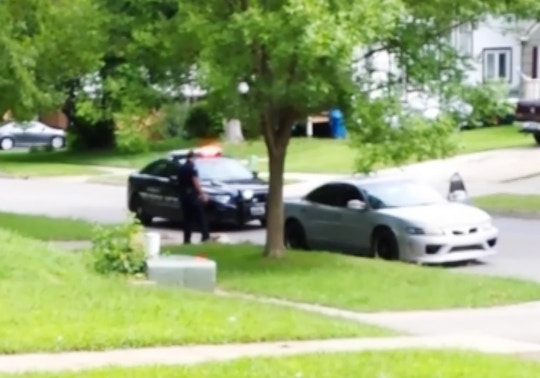
A screen grab from a bystander video of Bryce Masters lying on the ground after being tased by Officer Timothy Runnels, Sept. 14, 2014.
Image: Youtube
A full 23 seconds after Runnels pulled the trigger on the X26 Taser, he let it go and handcuffed Bryce. But Bryce wasn't moving. Runnels told him to get up. Bryce didn't budge. So Runnels grabbed him by the arms and pulled him, with the boy's legs dragging on the ground between Runnels' shuffling feet, toward the side of the road. Then Runnels released Bryce's arms and allowed him to drop face first onto the street. A snapping thud filled the room — the sound of Bryce's 175-pound frame hitting the pavement as his teeth crashed together and his jaw dislocated.
Bryce began to moan."You don't like to play by the rules, do you," Runnels said. The Masters could see Bryce's heart heaving up and down on the screen, an indication that he was going through cardiac arrest. Runnels seemed to ignore all this and, as the video shot by a neighbor makes clear, he put his right foot onto Bryce's back. "Bryce, better sit up," he said. "I don't play games."
Bryce didn't respond.
"I've been tased a dozen times," Runnels said to Bryce. "It doesn't act like that."
Another officer arrived on scene and Runnels explained that there was a warrant on Bryce's plate — ostensibly the reason for the stop. The new officer referred to Bryce, lying there stationary. "Wake up, guy," the officer said. Then, to Runnels: "He's turning blue."
Watching the video, Stacy was astounded."I felt like he would have cared for an injured animal better."
"I will never get over the fact that he put his foot on Bryce's back, while he was literally dying," she said. "I don't think I'll ever, ever be able to forget that."
As hard as it was to watch, Bryce felt vindicated. He had done exactly what his parents told him to do. "Nothing I could've done would have stopped him that day. I didn't do anything wrong." Still, seeing himself abused like that was surreal. He was transported back to the moment when everything changed, and despite how hard his life had become, he thought he would do it all the same way again. "If that's my right, why would I let some cop try to take it away?"
Matt felt betrayed. The video shook the convictions he had always held about law enforcement officers. "Instead of putting faith in my own son, I put faith in that Runnels was a cop — and that he knew what he was doing, and that he was a professional."
Matt had such visceral feelings of loyalty and camaraderie toward his fellow officers that he'd previously been comforted by the assumption Bryce was somehow at least partially culpable for what happened to him. That faith had allowed him to rationalize Runnels's actions, but there was no rationalizing what was on that recording. It was deliberate, cold, and devoid of empathy or humanity. "I don't understand, when you watch that video, how you could treat anybody's kid that way."
The dashcam video showed officers searching through Bryce's vehicle as Bryce was carted off in an ambulance. In the video, Runnels refers to Bryce's August arrest, which was being contested by the Masters. Another officer put his head inside Bryce's car and said, "It stinks bad in there" — like marijuana. It was clear this was not a random stop; Runnels knew exactly who Bryce was.

Bryce Masters at his home on June 2, 2016.
Photo: Jason Dailey for The Intercept
T oward the end of Runnels' sentencing hearing on May 26, Bryce stepped to the front of the courtroom to give his victim impact statement. He sat on the witness stand and addressed the room, detailing what Runnels took from him. He described a happy teenage life before this all happened, the life of a young man who was looking forward to his senior year of varsity basketball, and visiting colleges. While he was able to finish high school, he didn't have the motor skills for sports anymore, and his diminished ability to think critically made college unlikely. He said he'd once been funny and quick-witted, and could fit in with lots of different groups. But after his interaction with Runnels, his friendships faded as his classmates realized how emotionally unpredictable he'd become.
He wanted the judge to know he was a good person, a strong person, and despite all he'd been through, determined to make the most out of his life. However, the future he once imagined for himself was now likely out of reach. "People tell me I'm different," he admitted to the crowd. "And I am."
After almost 20 years as a cop, it had become easy for Matt to split the world into good guys and bad guys. Today, he sees law enforcement through the eyes of a victim. While he still values the profession, his newfound empathy made him more aware of the real damage some officers inflict. "Cops do fuck up. Cops do make bad decisions. And, when they do, there's someone on the receiving end of that."
In his son's case, an officer is paying for his bad decision. In a final sentencing hearing on June 1, Runnels was sentenced to four years in federal prison. When asked if he still has faith in the system, considering that Runnels is one of the rare officers to face criminal punishment for using excessive force, Matt shakes his head no. He knows there are many deserving cases, especially involving minority victims, that never see the inside of a courtroom. "I get a lot of sympathy from my black cop friends, like, 'this is what we've been saying about cops for a long, long time.'"
The dashcam video, which has been sealed by the court, is definitive and ugly, and Runnels's actions are impossible to justify. Matt believes Runnels should have never been hired by Independence after he resigned from Kansas City. He believes that when Runnels said, "All right, fine, fuck it," he was making a conscious decision to punish Bryce. But he also believes Runnels's argument that he didn't know that Tasers could cause cardiac arrest.
"Taser's told everybody, If you've got to put your hands on somebody, why? Why risk getting hurt? Just shoot them with the Taser, and it's over and done with."
When Matt watches his son suffer, he sees the marriage of a police culture that is too eager to blindly justify force and a company shrewd enough to take advantage. Matt sees the good in what Tasers can do, under the right circumstances. But he doesn't trust the company selling them. He acknowledges that the number of Taser deaths is small compared with the total number of Taser deployments, but he worries about the people like Bryce who are unnecessarily put at risk. "What does an officer know about the Taser?" he asked. "Everything Taser told them."
While Taser International has updated its material to mention potential cardiac risks (as well as several other ways the weapons can cause injury or death), Matt sees that as mere fine print that neither the company nor many officers take seriously. Rick Guilbault, the former head of training at Taser International, testified on behalf of Runnels that his use of the Taser was consistent with common practice and training. He even argued that using the Taser for 20 seconds was reasonable because Runnels didn't have control of Bryce until it was over.
"Taser's told everybody, If you've got to put your hands on somebody, why? Why risk getting hurt? Just shoot them with the Taser, and it's over and done with," Matt said. "And, to this day, we're what, 15 years later since it's hit the vast majority of departments, that's still the narrative."
Matt thinks back to his initial training in 2004, when he was assured that the weapon's electric current would not cause death. Now, he sees a company with everything at stake trying to have it both ways: Tasers are safe for all sorts of encounters, but don't blame us when something goes wrong.
"It's sickening to me to listen to Taser even speak," Matt continues. "We've all been duped. We've been fooled by a company that has made millions and millions of dollars off of the police departments."
Runnels may have been a bad cop, but if he hadn't been given a device that Taser International had assured him was extremely unlikely to kill, then he might not have been tempted to shock a teenager who simply wanted to know why he was being arrested.
This article was reported in partnership with The Investigative Fund at The Nation Institute.
richardforkildney.blogspot.com
Source: https://theintercept.com/2016/06/07/tased-in-the-chest-for-23-seconds-dead-for-8-minutes-now-facing-a-lifetime-of-recovery/
0 Response to "Funny Cop Arrest Gjy Screams Bevause of Tasrer"
Publicar un comentario